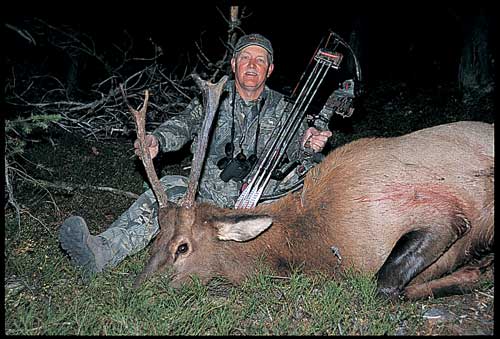Previously: Wallows And Waterholes, Keep’em Talking
Beat The Heat
 “Nice weather” often translates into “bad elk hunting.” I spent five days with guide Nathan Davis of Crow Creek Outfitters, hunting the western section of the Crazy Mountains. Each day the sun blazed, raising temperatures to record levels. At night, temperatures rarely dipped below 50 degrees.
“Nice weather” often translates into “bad elk hunting.” I spent five days with guide Nathan Davis of Crow Creek Outfitters, hunting the western section of the Crazy Mountains. Each day the sun blazed, raising temperatures to record levels. At night, temperatures rarely dipped below 50 degrees.
Though Nathan Pitcher and I hunted separate sections of Montana, in comparing notes we found we experienced similar challenges. The warm weather seemed to restrict elk movement and kept them in the timber. Even though we glassed exhaustively around dawn and dusk, locating elk was much more difficult than it should have been for the last week of September. With no audible location fix, we searched for fresh sign, especially rubs on trees. A cold-calling tactic eventually paid off.
Isolated water sources could have been a good focal point, yet the Crow Creek Ranch I hunted had an abundance of streams, springs, and drinking places. We glassed meadows and parks surrounded by pine and spruce, yet saw very few animals.
When bulls just aren’t talking, bugling in the dark can often pinpoint their location so a daytime strategy can be planned. I have hunted with guides who drive back roads throughout the night, stopping every mile or so to bugle. Some scout all night long.
Locating elk in the middle of the night falls squarely into the weird and wacky category of elk tactics. Pressured elk may only bugle in darkness, and getting a bearing on the herd’s location is critical information that can lead to success the next morning.
Prepare To Succeed
Elk can be vulnerable to off-the-wall tactics, yet archers must make all the standard preparations to consistently succeed. You should maintain top physical condition, be proficient with your bow to 30 yards, and have well-tuned arrows, broadheads, and other gear. You don’t need a magnum bow, but quality gear can make a difference. I bagged a 3x2 bull on the last day of my Montana hunt—not a monster, but a good-eating animal that tested the mettle of my gear.
The bull that breathed down my neck proved the effectiveness of my Realtree camo and the Hunter’s Specialties scent elimination system. Each night, I placed my clothes in a Scent-Safe bag with fresh earth scent wafers.
Which all proves one thing: I might have the experience and know-how to prepare for hunting elk in the West. How to mentally handle a big bull bugling in your hip pocket—well, that’s another matter entirely!
7 Sneaky Tricks
When standard elk tactics aren’t working, give these a try.
1. Stalk silently. Use cow calling only when detected. Works best if a buddy can keep an elk talking.
2. Scout in the dark. Use wimpy “locating bugles” to locate elk in early morning darkness.
3. Use a decoy. The sight of a “runaway bride” is more than most herd bulls can stand. Be prepared. They may come running.
4. Try a treestand. Find a wallow or watering hole and use your Eastern deer tactics. Elk usually water early and late, but can drink at midday.
5. Cold-call in areas of elk activity. Look for fresh rubs and places that smell like elk. Set up, cow call, and be alert.
6. Don’t bust the herd. It’s better to back off when the wind is wrong and return.
7. Finally, be mobile—follow the elk. Roam safely, yet be prepared to go the distance.






